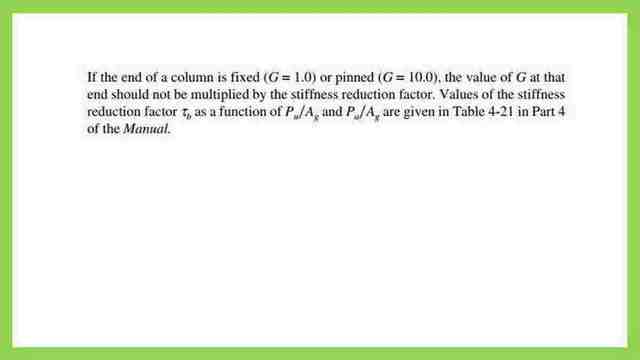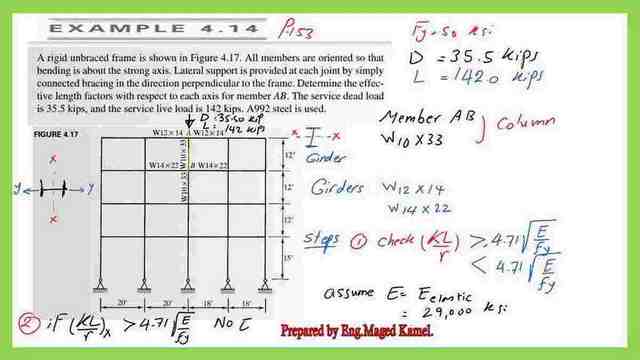Solved problem 4-14-effective length factor-part 1.


G values for pinned columns and for Fixed columns.
There is an important remark if the end of a column is fixed (G=1) or pinned G=10.00, the value of G at that end should not be multiplied by the stiffness reduction factor τb. So we do not use τb for the hinged or fixed end column but can be used for all the other cases.


Solved problem 4-14-effective length factor
Let us refer to the solved problem 4-14, page 153 from Prof. Segui, we have a multi-story frame, A rigid un-braced frame is shown in Figure 4.17 the plane of the web is in the plane of the paper.
The web of all beams intersects with the web of columns. both beams and columns have w sections. Lateral support is provided at each joint by simply connecting bracing in the direction perpendicular to the plane of the frame. X is the multistory frame horizontal distance, z is vertical elevation, and at the direction of y there is a bracing k value in the y-direction=1.


Determine the effective length factors concerning each axis for member AB, which means that, for both x and y directions, k is to be estimated. concerning each axis. For column AB, we need not worry about whether we have fixed or hinged support for the τb, stress reduction factor if columns have inelastic buckling.
For normal joint τb can be multiplied. As if we have load acting at the top of column AB, the values are as follows, DL=35.50 kips, LL=142.0 kips.
Let us check the given data, for member AB, the column section is W10x33 at joint A, there are two beams both have a W12x14 section, one beam length=20′, while the other beam length is 18 ft, while for columns the length of each column is 12′.
So far, we do not know, whether column AB is a long or short, or intermediate column. This depends on whether its KL/r is > or <4.71(sqrt(E/Fy), recall if the k*L/r value for column > 4.71(sqrt (E/Fy) the column is long, in that case, no need for The stiffness reduction factors τb estimate τb.
Since τb is stress reduction is due to the inelastic behavior, of the column. K*L/r value for column <4.71(sqrt(E/Fy), then we proceed in estimating τb for the LRFD and ASD designs.
Estimation of Pult, Pns, and α values.
In such a case for LRFD, we need to evaluate the ultimate load Pult, Pns, and α values for the general equation or through the table.
First, we assume that the column is long so E= 29000 ksi. For the step, calculate Ga and Gb of column AB, and get the K value.
We will continue with the solved problem as part 2 in the next post.
This is the pdf file used in the illustration of this post and the next post.
Go to the next post, Solved problem-4-14 part 2.
A very useful external link A very useful external link. A Beginner’s Guide to the Steel Construction Manual, 15th ed.

